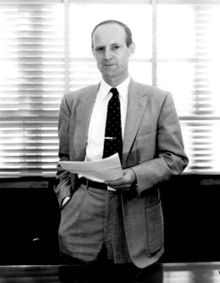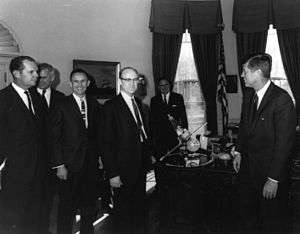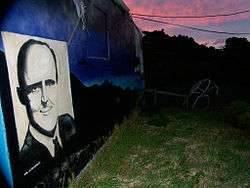Bill Pickering (rocket scientist)
William Hayward "Bill" Pickering ONZ KBE (24 December 1910 – 15 March 2004) was a New Zealand-born rocket scientist who headed Pasadena, California's Jet Propulsion Laboratory (JPL) for 22 years, retiring in 1976.[1][2] He was a senior NASA luminary and pioneered the exploration of space. Pickering was also a founding member of the United States National Academy of Engineering.[3]
William Hayward Pickering ONZ KBE | |
|---|---|
 William H. Pickering, JPL/NASA Photo | |
| Personal details | |
| Born | 24 December 1910 Wellington, New Zealand |
| Died | 15 March 2004 (aged 93) Flintridge, California, USA |
| Citizenship | New Zealand, United States |
| Nationality | New Zealand, United States |
| Known for | Space aeronautics pioneering |
| Awards | Magellanic Premium (1966) IEEE Edison Medal (1972) National Medal of Science (1975) Delmer S. Fahrney Medal (1976) Japan Prize (1994) Daniel Guggenheim Medal (2000) |
Origins and education
He was born in Wellington, New Zealand on 24 December 1910. Pickering attended Havelock School, Marlborough, and Wellington College. After spending a year at the Canterbury University College, he moved to the United States (where he subsequently naturalized), to complete a bachelor's degree at the California Institute of Technology ("Caltech"), and later, a PhD in Physics, in 1936. His speciality was in Electrical Engineering, and he majored in what is now commonly known in scientific vernacular as 'telemetry'.[1]
Jet Propulsion Laboratory
William Pickering became involved with JPL in 1944, during the second world war.
As the Director of JPL, from 1954, Pickering was closely involved with management of the Private and Corporal missiles under the aegis of the U.S. Army.[1]
His group launched Explorer I on a Jupiter-C rocket from Cape Canaveral on 31 January 1958 less than four months after the Soviet Union had launched Sputnik.
In 1958 the lab's projects were transferred to the National Aeronautics and Space Administration (NASA) and Pickering's team concentrated on NASA's unmanned space-flight program. JPL, under Pickering's direction flew further Explorer 3 and Pioneer missions as well as the Ranger and Surveyor missions to the moon and the several Mariner flybys of Venus and Mars.
Explorer III discovered the radiation field round the earth that is now known as the Van Allen radiation belt. Explorer 1 orbited for 10 years and was the forerunner of a number of successful JPL earth and deep-space satellites. William Hayward Pickering is not to be confused with William Henry Pickering, an astronomer from an earlier era.
At the time of his retirement as director, in 1976, the Voyager missions were about to launch on tours of the outer planets and Viking 1 was on its way to land on Mars.
Retirement
Bill Pickering, keen to support authentic science in his home country, was Patron of New Zealand's only school-based research group,[4] the Nexus Research Group, from 1999 until his death in 2004. Between 1977 and his death in 2004, Pickering also served as Patron of the New Zealand Spaceflight Association; a non-profit organisation that existed from 1977 to 2012 to promote an informed approach to astronautics and related sciences.
Death
He died on 15 March 2004 of pneumonia in La Cañada Flintridge, California, USA.[1]
Gifford Observatory
Pickering re-opened the Gifford Observatory as the guest of honour, on 25 March 2002.[5] He had been a frequent user of the observatory during his school days in Wellington College.
Honours
- In 1964, he was awarded the Golden Plate Award of the American Academy of Achievement.[6]
- In 1964 he presented the Bernard Price Memorial Lecture in South Africa.
- 1965 The Institution of Professional Engineers New Zealand (IPENZ) Honorary Fellowship
- Magellanic Premium in 1966.
- IEEE Edison Medal in 1972, For contributions to telecommunications, rocket guidance and spacecraft control, and for inspiring leadership in unmanned exploration of the solar system.
- National Medal of Science in 1975 awarded by President Gerald Ford
- Honorary (because of his American citizenship) investiture as a Knight Commander of the Order of the British Empire in 1975
- In 1980 he was inducted into the International Space Hall of Fame.[7]
- In 1979, Pickering was inducted into the International Air & Space Hall of Fame at the San Diego Air & Space Museum.[8]
- Japan Prize in 1994
- In the 2003 Queen's Birthday Honours, he was appointed an honorary member of the Order of New Zealand,[9] the highest civilian award in the New Zealand honours system.
- Dr. Pickering is one of the few non-politicians to have appeared on the cover of Time magazine twice.
Honorific eponyms
In 2009 to mark the International Year of Astronomy, William Hayward Pickering was selected along with cosmologist Beatrice Tinsley to have their names bestowed on peaks in the Kepler Mountains of New Zealand's Fiordland National Park. In December 2010 the New Zealand Geographic Board officially gazetted Mount Pickering as an official New Zealand place name.[10]
Three roads in New Zealand have been named after Pickering, namely: Sir William Pickering Drive in the Canterbury Technology Park in Christchurch; Pickering Crescent in Hamilton; and William Pickering Drive in Auckland.
In December 2018 New Zealand company Rocket Lab announced that the fourth launch of their Electron rocket and their first mission for NASA's Educational Launch of Nanosatellites program will be named "This one's for Pickering", in honor of Bill Pickering.[11]
Minor planet 5738 Billpickering is named in his honor.[12]
Gallery
 Pickering and Kennedy with a model of the Mariner 2 spacecraft
Pickering and Kennedy with a model of the Mariner 2 spacecraft Pickering, Van Allen & Von Braun at NASA news conference.
Pickering, Van Allen & Von Braun at NASA news conference. Observatory Mural showing Sir William Pickering.
Observatory Mural showing Sir William Pickering. Mount Pickering Summit, Kepler Mountains Fiordland National Park New Zealand.
Mount Pickering Summit, Kepler Mountains Fiordland National Park New Zealand.
References
- Wilford, John Noble (17 March 2004). "William H. Pickering, 93, Leader in Space Exploration, Dies". The New York Times. Retrieved 19 February 2015.
William H. Pickering, a leader of the first successful space flight by the United States and its first two decades of planetary exploration, died on Monday at his home in La Cañada Flintridge, Calif. He was 93. ...
- Casani, John R. (November 2004). "Obituary: William Hayward Pickering". Physics Today. 57 (11): 86–87. Bibcode:2004PhT....57k..86C. doi:10.1063/1.1839390.
- "Founding members of the National Academy of Engineering". National Academy of Engineering. Retrieved 21 October 2012.
- "William Pickering and the NASA connection". Nexus Research Group. Retrieved 18 June 2015.
- Douglas J. Mudgway (2008). William H. Pickering: America's Deep Space Pioneer. Government Printing Office. p. 229. ISBN 978-0-16-081536-2.
- "Golden Plate Awardees of the American Academy of Achievement". www.achievement.org. American Academy of Achievement.
- McClellan, Doug (5 October 1980). "Space Hall of Fame Honors Four". El Paso Times. El Paso, Texas. p. 1B – via Newspapers.com.
- Sprekelmeyer, Linda, editor. These We Honor: The International Aerospace Hall of Fame. Donning Co. Publishers, 2006. ISBN 978-1-57864-397-4.
- "Queen's Birthday honours list 2003". Department of the Prime Minister and Cabinet. 2 June 2003. Retrieved 19 June 2020.
- "Mount Pickering and Mount Tinsley in the Kepler Range". RASNZ. Archived from the original on 29 April 2011. Retrieved 16 June 2013.
- https://www.rocketlabusa.com/news/updates/rocket-lab-prepares-to-launch-historic-small-satellite-mission-for-nasa/
- |(5738) Billpickering In: Dictionary of Minor Planet Names. Springer. 2003. doi:10.1007/978-3-540-29925-7_5417. ISBN 978-3-540-29925-7.
External links
| Wikimedia Commons has media related to William H. Pickering. |
- IEEE Legacies
- Biography of William Pickering by The New Zealand Edge
- Faces of Leadership: the Directors of JPL
- William H. Pickering on NASA website
- New Zealand Spaceflight Association
- A biography by John Campbell
- RSNZ obituary (Archived 5 June 2004 at the Wayback Machine)
- Caltech obituary (Archived 15 June 2004 at the Wayback Machine)